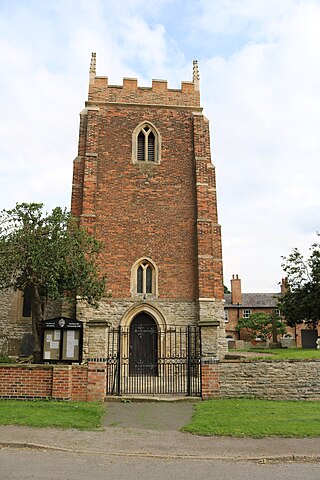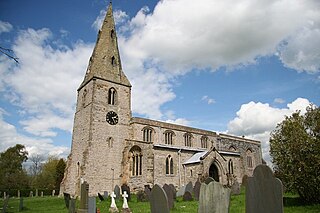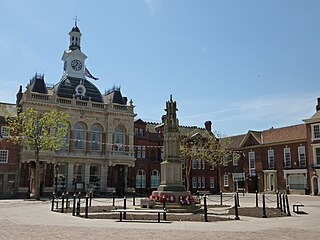
Retford, also known as East Retford, is a market town in the Bassetlaw District in Nottinghamshire, England, and one of the oldest English market towns having been granted its first charter in 1105. It lies on the River Idle and the Chesterfield Canal passes through its centre. Retford is 26 miles (42 km) east of Sheffield, 23 miles (37 km) west of Lincoln and 31 miles (50 km) north-east of Nottingham. The population at the 2021 census was 23,740.

John Carr (1723–1807) was a prolific English architect, best known for Buxton Crescent in Derbyshire and Harewood House in West Yorkshire. Much of his work was in the Palladian style. In his day he was considered to be the leading architect in the north of England.

Widmerpool is a village and civil parish in Nottinghamshire, about 10 miles south-south-east of Nottingham and some 7.5 miles north-east of Loughborough. It is one of Nottinghamshire's oldest settlements and is just over a mile west of the A46. Extensive dual carriageway road works along the A46 have now been completed. At the time of the 2001 census it had a population of 262, increasing to 339 at the 2011 census. Until the 1960s there had not been any building in the village for 100 years.

Sheffield Old Town Hall is a building in Waingate in central Sheffield, South Yorkshire, England, opposite Castle Market. It is a Grade II listed building.

Hafodunos Hall is a Gothic revival house located near the village of Llangernyw in Conwy, Wales. Designed by Sir George Gilbert Scott, it was built between 1861 and 1866 for Henry Robertson Sandbach, replacing a house that had been built in 1674.

Upton Hall is the headquarters of the British Horological Institute (BHI) in Upton, Newark and Sherwood, Nottinghamshire, England. It has been the headquarters since 1972. It also houses the Museum of Timekeeping consisting of a substantial collection of clocks, watches and also a library. The Museum is open to the public during seasonal summer opening hours, for special events and for pre-booked Group tours.
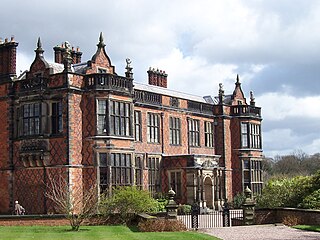
Arley Hall is a country house in the village of Arley, Cheshire, England, about 4 miles (6 km) south of Lymm and 5 miles (8 km) north of Northwich. It is home to the owner, Viscount Ashbrook, and his family. The house is a Grade II* listed building, as is its adjacent chapel. Formal gardens to the southwest of the hall are also listed as Grade II* on the National Register of Historic Parks and Gardens. In the grounds are more listed buildings, a cruck barn being listed as Grade I, and the other buildings as Grade II.

Dorfold Hall is a Grade I listed Jacobean mansion in Acton, Cheshire, England, considered by Nikolaus Pevsner to be one of the two finest Jacobean houses in the county. The present owners are the Roundells.

St Leonard's Church is a Church of England parish church in Wollaton, Nottinghamshire, England. Dating originally from the 13th century, the church was restored in the Victorian era and again in the 20th century. It is notable for the large number of funerary monuments it contains. Many are to the Willoughby family, of nearby Wollaton Hall. There is also a memorial to Robert Smythson, designer of the hall, and one of the first English architects. The church is a Grade II* listed building.

Henry Clutton was an English architect and designer.
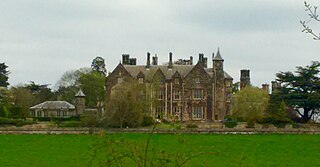
Kingston Hall is a country house in Kingston on Soar, Nottinghamshire.

St Swithin's Church, Wellow is a Grade II* listed Church of England parish in the Diocese of Southwell and Nottingham in Wellow, Nottinghamshire.

There are over 20,000 Grade II* listed buildings in England. This page is a list of these buildings in the county of Nottinghamshire, by district.
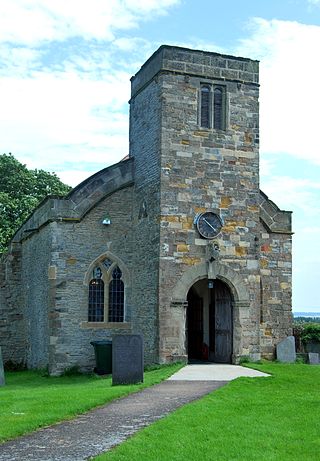
St Margaret's Church, Owthorpe is a Grade II* listed parish church in the Church of England in Owthorpe, Nottinghamshire, England.

Upper Broughton or Broughton-Sulney or Over-Broughton is a village and civil parish about seven miles north west of Melton Mowbray, in the Rushcliffe district of the county of Nottinghamshire, England. In 2011 the built-up area had a population of 327, the same as the parish. The parish touches Wymeswold, Hickling, Widmerpool, Broughton and Old Dalby and Willoughby on the Wolds. Upper Broughton is a conservation area that was designated in 1973 and is 16 hectares. It is near the boundary with Leicestershire, and Nether Broughton is across the county boundary.
Widmerpool is a civil parish in the Rushcliffe district of Nottinghamshire, England. The parish contains four listed buildings that are recorded in the National Heritage List for England. Of these, one is listed at Grade II*, the middle of the three grades, and the others are at Grade II, the lowest grade. The parish contains the village of Widmerpool and the surrounding area. All the listed buildings are in the village, and consist of a church, a former country house, and two smaller houses.












